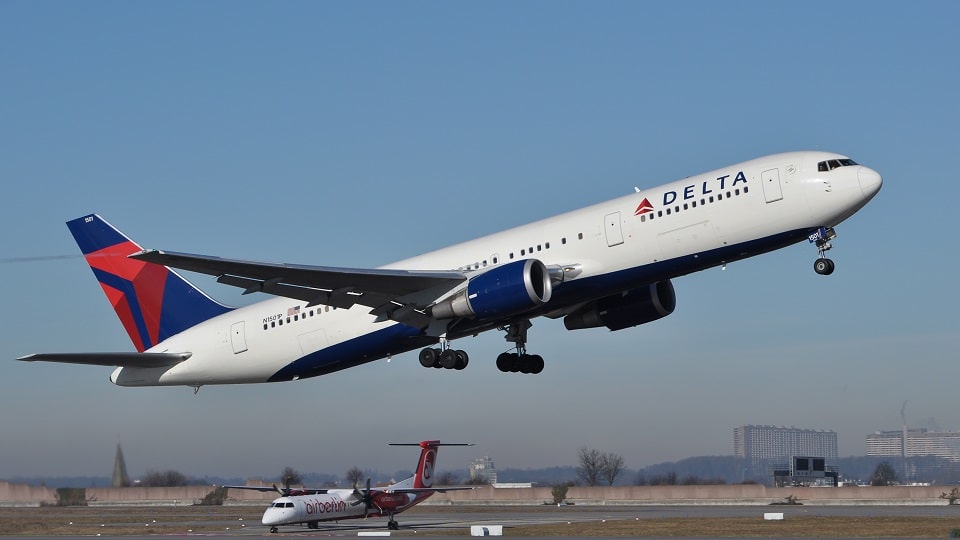Aviation
Delta Launches Free Wi-Fi Service on Long-Haul Flights

Delta Air Lines is elevating the in-flight experience for its international passengers with the introduction of free Wi-Fi on select long-haul flights, marking a significant step toward its goal of offering complimentary connectivity across its entire global fleet.
This summer, passengers on Viasat-equipped aircraft will be able to enjoy fast, free Wi-Fi, courtesy of T-Mobile, enabling seamless connectivity for streaming, browsing, and staying in touch with loved ones while soaring across the skies.
Here is how you can you work as delta airlines remote jobs:Click here
Currently, Delta has equipped nearly 700 of its aircraft, representing over 90% of its domestic mainline fleet, with this advanced Wi-Fi service. By the end of the year, the airline anticipates that the majority of its customers will have access to free, high-quality internet during their flights.
The roll-out on international routes airport wifi password is being implemented strategically, with Delta ensuring that each route is equipped with the reliable, high-speed service that its customers expect.
To manage this ambitious roll-out effectively, Delta is introducing free Wi-Fi on its Viasat-equipped widebody aircraft on a route-by-route basis, mirroring the successful strategy used for domestic installations in 2022. This phased approach allows the airline to maintain the high standard of service it is known for while expanding its Wi-Fi offering globally.
As the service expands internationally, Delta is making the experience as seamless as possible for passengers. Initially, the international Wi-Fi portal will not require a SkyMiles login. However, later this year, the airline plans to transition all Viasat Wi-Fi-equipped aircraft to the Delta Sync Wi-Fi experience, which will be accessible through SkyMiles memberships, offering passengers personalized onboard experiences and exclusive offers.
Soon, Air India aircraft will feature onboard WiFi and all-new cabins:Click here
In recent developments, Delta has rolled out free Wi-Fi on most flights to and from France, including routes to Paris-Charles de Gaulle (CDG) and Nice Côte d’Azur (NCE) from all U.S. stations. The airline is also planning to extend this service to its regional routes, with the full roll-out expected to be completed by 2025, including those operated by Boeing 717 aircraft.
During this transition, there will be some coverage gaps due to the positioning of additional satellites needed to provide full global coverage. Until these satellites are operational, some aircraft will continue to offer a paid Wi-Fi experience through Intelsat. delta airline remote jobs
does air india have wifi on international flights? Delta is committed to keeping its passengers informed about the availability of free Wi-Fi on their flights through various channels, including its website, pre-flight emails, app notifications, and in-flight announcements.

Aviation
Airbus Enhances A350 Cabin with 10-Abreast Seating

Airbus has announced a new partnership with Jiatai Aircraft Equipment, a Chinese aircraft seating manufacturer, to supply upgraded economy-class seats for the A350 widebody series.
This collaboration, unveiled at the 2024 Airshow China, focuses on developing a newly designed economy seat tailored for the A350‘s New Production Standard (NPS) cabin.
One of the key features of the NPS cabin is the ability to accommodate 17-inch wide economy seats, compared to the previous 16.5-inch wide seats that airlines were limited to in the A350’s earlier configurations.
British Airways Unveils Its Brand-New First Class Cabin for the Airbus A380
This change is made possible by the expanded space in the NPS cabin, which is 35 inches longer and 4 inches wider than the previous version. This extra space is achieved by slightly moving the cockpit wall forward and shifting the rear pressure bulkhead back by one frame.
The wider cabin allows airlines to add up to 30 extra economy seats without compromising comfort. For airlines opting for a 3-4-3 seating layout, the 17-inch wide seats are an excellent choice for a more comfortable passenger experience. However, some airlines, such as Iberia, may choose to retain a 9-abreast layout with wider seats for added comfort.
The NPS cabin also offers enhanced flexibility for airline operators. One major advantage is the ability to easily switch between a 9-abreast and 10-abreast seating configuration without requiring significant downtime for aircraft reconfiguration. Airlines can use the same seat rails, tracks, and IFE interfaces, making the transition smoother and quicker.
Etihad Airways Unveils 10 Exciting New Routes for 2025
In addition, the design of the floor attachments and air-conditioning systems has been optimized for 10-abreast seating, meaning airlines can upgrade their cabins without needing to make substantial modifications to the aircraft’s structure.
Though it’s still unclear when Jiatai’s economy-class seats will be officially added to the A350’s Buyer Furnished Equipment (BFE) catalogue, the collaboration marks a significant step toward enhancing the A350’s cabin offerings.
With this partnership, Airbus is providing more seating options for airlines, ensuring that they can meet diverse customer needs while improving overall operational efficiency.
-

 Aviation2 months ago
Aviation2 months agoMicrosoft Flight Simulator Raises $3 Million to Bring Back the An-225 Mriya
-

 Airlines2 months ago
Airlines2 months agoQatar Citizens Can Travel to the United States Without a Visa
-

 Aviation2 months ago
Aviation2 months agoQatar Airways bans these new Electronic Devices on plane
-

 Airlines2 months ago
Airlines2 months agoJapan Airlines Rolls Out Free Domestic Flights to International Passengers
-

 Defence2 months ago
Defence2 months agoWhich Country Has the Largest Fleet of Fighter Aircraft?
-

 Airport2 months ago
Airport2 months agoWestern Sydney Airport Welcomes Its First Plane After 6 Years of construction
-

 Airlines4 days ago
Airlines4 days agoDAMAC Air: Dubai’s New Luxury Airline Offers Free Flights for Registration
-

 Aviation2 months ago
Aviation2 months agoDid you know ? Once Boeing 747 carried 1088 passenger in 1991








